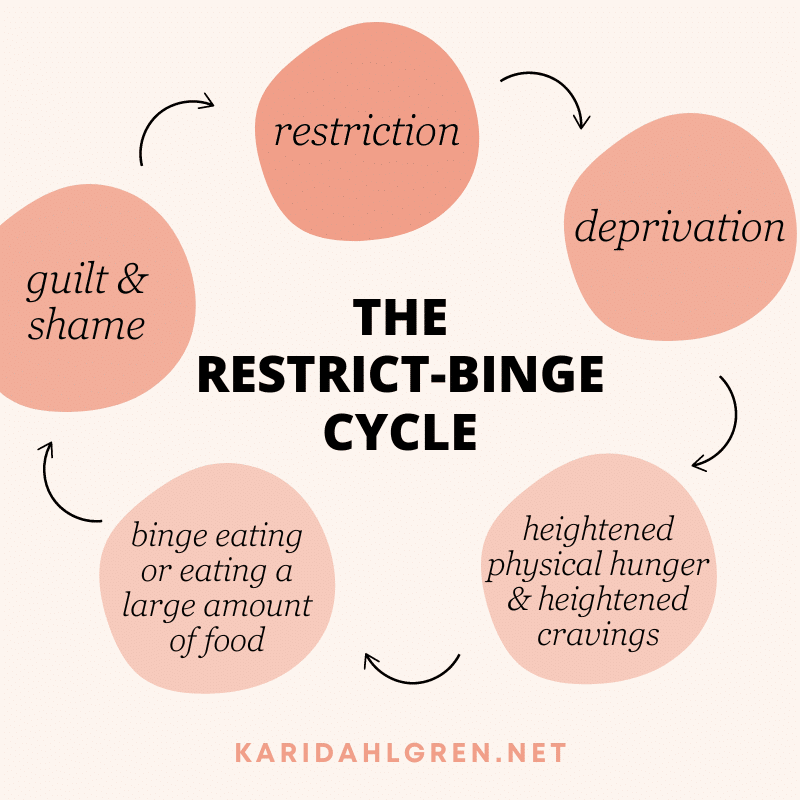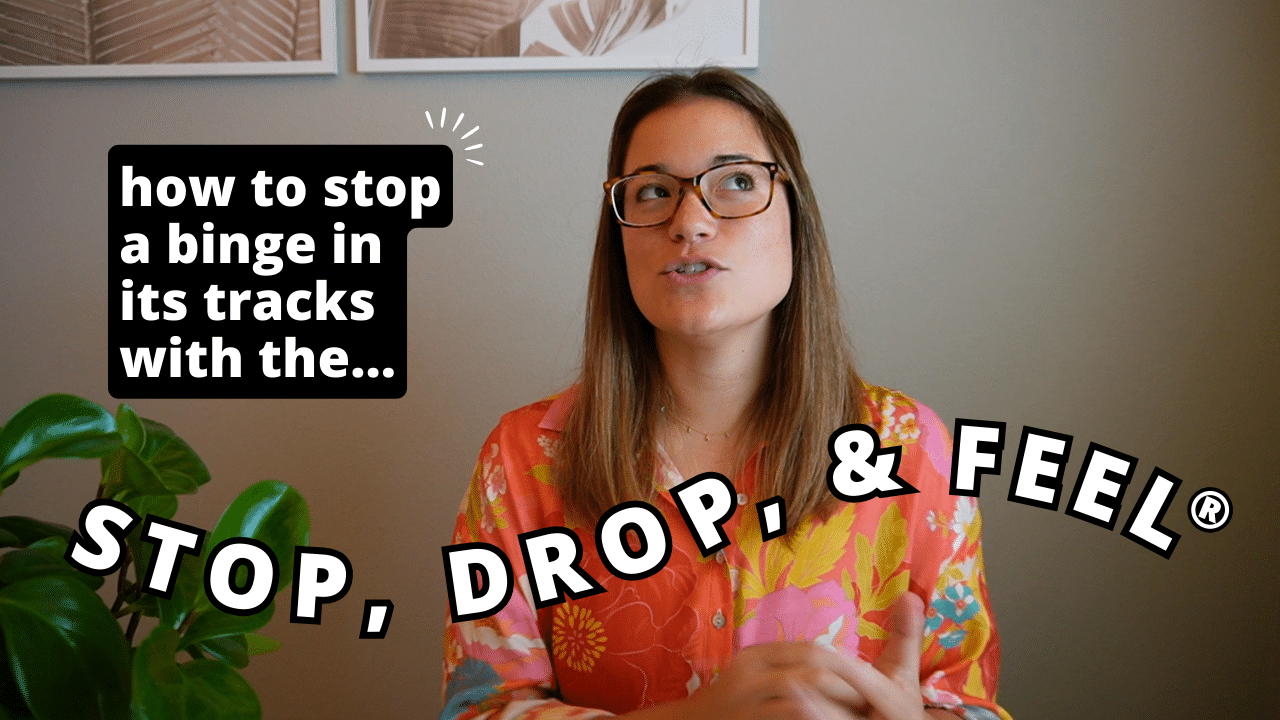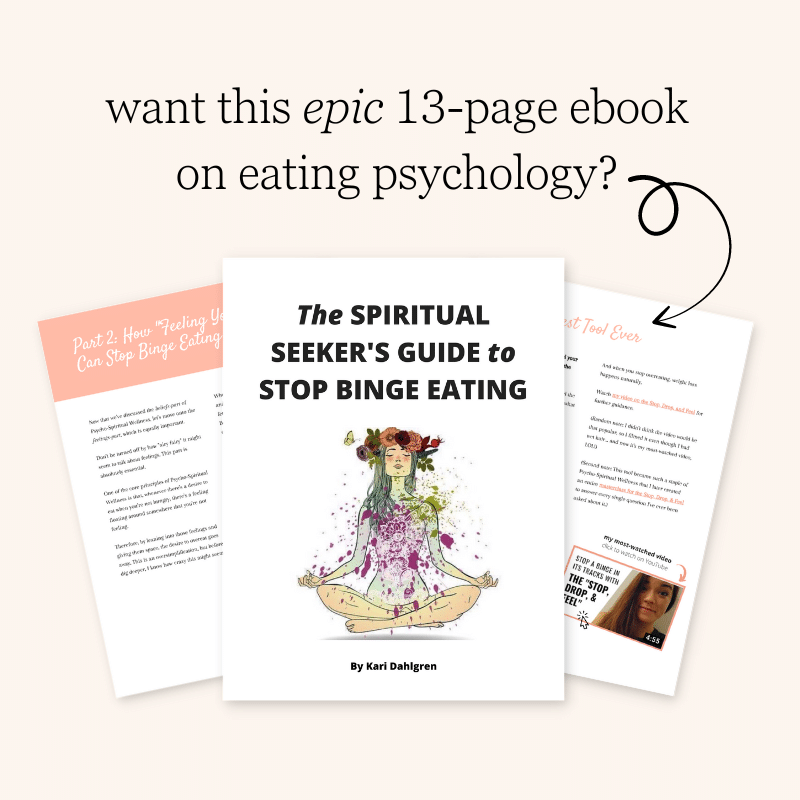
The restrict-binge cycle involves a ceaseless pendulum that swings from one extreme to the other: restricting food intake and feeling in control to eating large amounts of food while feeling utterly out of control. It often starts with good intentions—like trying to lose weight or reducing carb and sugar consumption—but it fuels a vicious cycle of yo-yo dieting.
What if there was a better way to promote health and well-being? What if we could eat when truly hungry, stop when comfortably full, and there was no need for “food rules” to regulate our eating? For many, this idea alone is the reason why we gravitate to food rules in the first place: there’s no feeling of control.
As you’re about to learn, being able to tolerate edgy feelings is precisely the path out of the restrict-binge cycle; along with giving up the restrictions altogether. If that sparks any fear, then buckle up, because this updated guide has everything you need to navigate this new territory.
Defining the Restrict-Binge Cycle
The restrict-binge cycle starts with restriction, which involves limiting food intake. It could involve a formal diet like Weight Watchers or Noom, or it could involve loose dietary intentions focused around avoidance—think: avoiding process foods, avoiding carbs and sugar, etc.
Generally speaking, you’re restricting your diet if you’re not listening to your body’s cues and instead eat based on calorie count, the time of the day, or macronutrients. Other signs that you’re restricting involve feelings of resentment around unrestrained eaters (e.g. does it trigger jealousy when you see someone eating intuitively instead of abiding by restriction?).
Binge eating, the flip side of restriction, is marked by consuming large amounts of food in a short time, accompanied by a loss of control. The DSM-5 criteria for Binge Eating Disorder (BED) include:[1]
Recurrent episodes of binge eating, characterized by:
- Eating a significantly larger amount of food than most would under similar circumstances within a set period (e.g., any 2-hour period).
- Experiencing a lack of control over eating during these episodes.
Binge-eating episodes include three (or more) of the following behaviors:
- Eating much more rapidly than normal.
- Eating until feeling uncomfortably full.
- Eating large amounts of food when not feeling physically hungry.
- Eating alone due to embarrassment about the quantity of food consumed.
- Feeling disgusted, depressed, or very guilty afterward.
Marked distress regarding binge eating is evident.
Frequency of binge eating is at least 1 day a week for 3 months.
The binge eating is not associated with compensatory behaviors (e.g., purging, fasting, excessive exercise) and is not exclusive to other eating disorders like anorexia or bulimia.
However, even without meeting these clinical criteria, many people experience compulsive eating in response to restriction. The pattern doesn’t need to fit a strict definition to be harmful. The essence of the restrict-binge cycle is in the ongoing tug-of-war between attempts to control food intake and consequential overeating, which can take a toll on our mental and physical well-being.
According to a study published in the Public Library of Science (PLoS) One, continuously gaining and losing weight—which is a common byproduct of the restrict-binge cycle—is associated with depression.[2]
Weight fluctuations are also associated with poor cardiometabolic health (think: increased risk of heart disease, hypertension, and diabetes), according to a study published in the Journal of Obesity & Metabolic Syndrome.[3]
There are clear consequences to dietary restraint, but what if you need to restrict your diet for your health? What if you’re restricting your diet because you have a medical condition or your doctor told you that you need to lose weight? We’ll explore these caveats after we dig into the mechanics of the restrict-binge cycle.
The Restrict-Binge Cycle Explained

There are 5 steps to the restrict-binge cycle, with each one fueling the pendulum as it swings from one extreme to the other. Before we can learn how to break free from the cycle, we must first understand what we’re dealing with.
1. Restriction: The restrict-binge cycle begins with intentions of restriction, often based on calories, time, or macronutrients (e.g. intermittent fasting, low-carb, “just eating less”). A study published in Frontiers in Nutrition found that restrained eaters are more likely to overeat than unrestrained eaters, especially in the face of food temptation.[4]
2. Deprivation: Restriction fuels feelings of deprivation, which can lead to increased cravings. Have you ever binged on pizza or pasta after following a low-carb diet? This could be one reason why. A study published in the journal Current Nutrition Reports found that short-term selective food deprivation increases cravings, particularly for the avoided food.[5]
3. Heightened Physical Hunger & Heightened Cravings: When overall food intake or calories are restricted, it increases physical hunger. When you’re extra hungry and fed up with feeling deprived, it’s a recipe for compulsive eating. This creates enormous frustration as it sabotages the original goal of eating less.
Furthermore, a brain scan study published in Physiology & Behavior found that people who try to restrict their eating but also have a strong craving for tasty foods have brain activity linked to both avoiding and wanting food.[6] Indeed, the internal tug-of-war isn’t just in your head—or rather, it is in your head, and you’re completely normal for experiencing it.
4. Binge Eating or Eating a Large Amount of Food: The restrict-binge cycle culminates in eating a large amount of food. It may fall into the criteria for binge eating, or it might not. Either way, it’s characterized by the pendulum swinging in the opposite direction, evoking feelings of frustration, resentment, and defeat.
5. Guilt and Shame: Finally, the restrict-binge cycle results in feeling of intense guilt, shame, and self-criticism followed by a vow to return to dietary restriction, sometimes even stricter than before.
While the restrict-binge cycle can have significant mental and physical health consequences, it’s important to recognize that not all dietary restrictions are created equal.
But What About Medically Necessary Restriction?
Medically necessary dietary restrictions, such as avoiding gluten for celiac disease or managing blood sugar levels for diabetes, typically do not trigger the restrict-binge cycle as long as they do not involve caloric restriction. A general rule of thumb is: if your dietary restrictions are motivated by wellness and not weight loss, you’re generally in the clear from triggering the restrict-binge cycle.
These guidelines can put us in a real bind if weight loss is our goal, though. The general advice for weight loss often includes eating less, which triggers the restrict-binge cycle. When caloric intake is significantly restricted, the body responds by increasing levels of the “hunger hormone” ghrelin, which increases hunger and the drive to eat.[7]
This is where set point weight theory comes into play. According to the research published in F1000 Medicine Reports, your body has a natural weight range that it tends to maintain.[8] When you lose weight, your body tries hard to gain it back, and when you gain weight, it doesn’t fight as hard to lose it.
Does this mean that weight loss is a hopeless goal? Well, one way to increase your set point weight is through dieting, not the other way around. Research published in Obesity Reviews shows that one-third to two-thirds of weight lost through dieting is regained within 1 year and almost all is regained within 5 years; and at least one-third of dieters regain more weight than they lost.[9]
If restrained eating can increase your set point weight, then unrestrained eating that honors your body’s hunger and fullness cues is a promising path forward. Not only can it allow your body to gradually reach a new “settling point” without rebelling against food deprivation, but it also fosters greater mental well-being.
How to Break Free from the Restrict-Binge Cycle
Before I gave up dieting, I constantly struggled with the restrict-binge cycle with carbs and sweets. I would often make it through dinner having limited my carb intake for the day, only to end up in bed with a growling stomach and incessant thoughts about bread, pasta, and cookies.
I used to make a two-fold mistake: I wasn’t eating enough, which was fueling overeating through undereating, and I was creating feelings of deprivation, which increased the psychological drive to eat the very foods I was restricting. Giving up dieting was a pillar of how I broke free from binge eating, and there were many other steps that went into it as well.
Here are some of my best tips for you:
1. Let Go of the Food Rules
To break free from the restrict-binge cycle, the restriction has to end. Remember that study I mentioned earlier about how restrained eaters are more likely to overeat than unrestrained eaters?[4] Imagine how much frustration and resentment you’ll spare yourself when you stop restricting.
However, this is easier said than done, as letting go of restriction sparks a fear of weight gain for many people. When the fear of weight gain is high, it can make giving up the food rules feel like an insurmountable obstacle. To help ease this anxiety, I have plenty of tips in my YouTube video below:

The most important tip that I share is that you don’t have to start with giving up dieting. While letting go of the food rules often fosters improved mental health, adding too much anxiety would do the opposite; so it’s important to work at a pace that’s right for you.
2. Embrace Food Flexibility
Adopting the ‘all foods fit‘ mentality can significantly ease feelings of deprivation, which helps diminish the restrict-binge cycle. This approach doesn’t classify foods as strictly good or bad but sees them as part of a broad, balanced diet.
Research supports this flexible eating style, suggesting that up to one-fifth of your diet can include low-nutrient foods without compromising overall nutrition.[10] Indeed, if you tend to restrict junk food, you may end up eating less of it when you let go of the food rules.
Now that we’ve addressed the ‘restriction’ side of the restrict-binge cycle, let’s address the ‘binge’ side. Again: the restrict-binge cycle is a pattern that anyone can experience regardless of the formal Binge Eating Disorder criteria we discussed earlier. If you struggle with BED, it’s best to work with a qualified dietitian.
3. Address the Urge to Binge
For anyone that struggles with the urge to eat beyond comfortable fullness, my Stop, Drop, & Feel® tool can help. It involves stopping yourself before a binge (the hardest part, of course, and I address that in the video below), dropping into your emotions, and feeling your feelings.

Behind the desire to eat without hunger is an uncomfortable emotion that we’re actively or subconsciously avoiding, and the Stop, Drop, & Feel addresses the emotions that desperately need attention. By carving out time to sit still with uncomfortable emotions, we develop tolerance for them—a skill I refer to as emotional tolerance.
Clinical literature refers to it as distress tolerance, and a study published in Eating Behaviors found that increased emotional tolerance helps reduce binge eating behaviors.[11] That alone is a great a reason to begin practicing this tool today.
4. Adopt Healthy Coping Mechanisms
Developing emotional tolerance takes time, resulting in a vulnerable period where emotion regulation skills aren’t strong enough to curb binge eating. This can make giving up restriction feel utterly void of control, tempting us to return to it.
This sense of unease or groundlessness may lead to relying on dietary restrictions for a false sense of safety, keeping us stuck in the restrict-binge cycle. To avoid this, equip yourself with non-food coping mechanisms that you can use in the meantime.
You don’t want to swap one coping mechanism (overeating) for another (like staying distracted) because it acts as a Band-Aid, never addressing the real problem: a need to address compulsion by developing emotional tolerance. In other words, if you use this step, please don’t skip the Stop, Drop, & Feel.
5. Eat Slowly and Mindfully
I’ve always felt a bit torn on pushing mindful eating and slow eating. Don’t get me wrong, they are helpful practices. Eating slowly is associated with better feelings of satisfaction after a meal.[12] And mindful eating helps promote intuitive eating experiences that honor the body’s cues of hunger and fullness.[13]
That said, early on in my journey of stopping compulsive eating by giving up dieting and focusing on the “inner work” (i.e. Stop-Drop-and-Feeling), I didn’t find either to be accessible. I couldn’t get myself to eat without distraction—no matter how much I wanted to—because distracted eating was compulsive.
And just like you can’t tell a compulsive eater to “just eat less” you also can’t tell a compulsive distracted eater to “just eat mindfully.” I did not yet have the emotional tolerance to sit still with myself while I ate.
So, please don’t beat yourself up if you find slow, mindful eating to be inaccessible. That’s perfectly normal, especially early on. Trust that, as you develop emotional tolerance, your ability to be with yourself will improve, and this eventually translates to slower, more mindful eating.
Breaking Free from the Restrict-Binge Cycle
In a world where restriction has become the new normal—with the majority of people restricting their food intake in some way—we’re all familiar with the consequence: the pendulum constantly swinging from feeling in control to feeling utterly out of control.
While the path out of the restrict-binge cycle involves giving up the food rules, follow your intuition. If you’re afraid of gaining weight and that fear alone triggers immense anxiety, then focus your effort on the Stop, Drop, & Feel first. Do what makes you feel challenged but not overwhelmed.
Embrace this process with curiosity and compassion, and allow yourself the space to grow. When you turn your relationship with food into a doorway to personal and even spiritual growth, you just might learn more about yourself than you ever thought possible.




I recently joined Noom, and while I do find myself learning some key tools to put into my arsenal against over-eating, I have been yearning for more in depth information about some of the topics discussed regarding the binge cycle as well as the psychology behind losing weight. Your videos and articles have helped me really dig deep into my own head and spirit. This is life-changing stuff, truly breaking ground for myself after over 40 years of having a terrible relationship and mindset about food. Thank you!
Hi Leslie! I’m genuinely touched to hear how my videos and articles have helped you. It’s wonderful that you’re finding value in the deeper exploration of eating psychology here. And your journey to improve your relationship with food after 40 years is truly inspiring. Keep following your spirit – that’s where the real transformation happens. <3 Thank you so much for taking the time to share this with me!